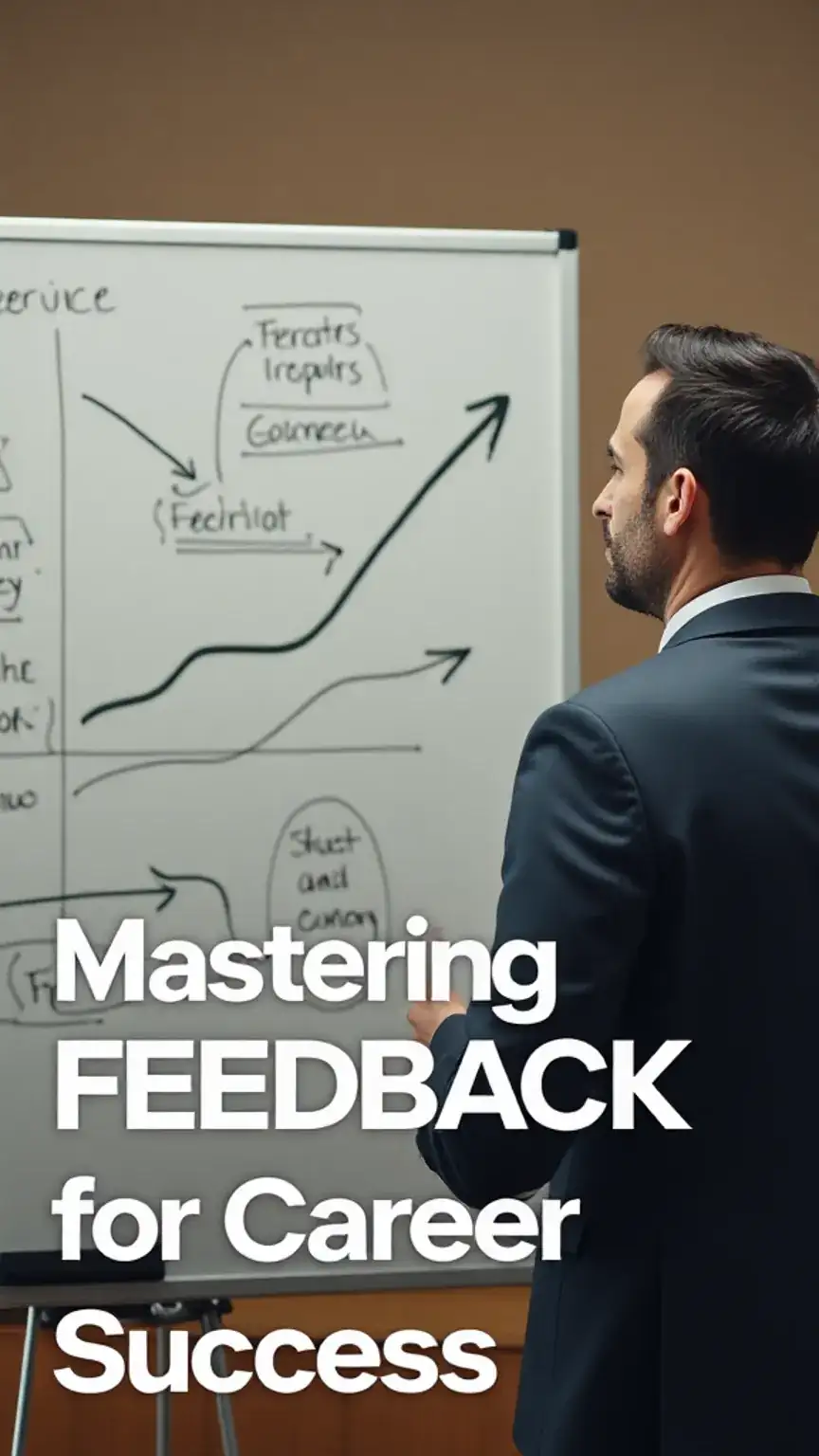Hey there, fellas! Let’s talk about something that can make or break our careers: constructive feedback. As a guy who’s been there, I know how easy it is to get stuck in a rut, whether it’s giving or receiving feedback. But trust me, it’s a crucial skill to master if you want to level up your professional game. Imagine walking into a room where your confidence precedes you, not because you’re boastful, but because you’ve honed your ability to communicate effectively. That’s the power of mastering feedback. Your future self will thank you for reading this.

Heads-up: this post contains affiliate links. That means I may earn a small commission if you click and buy — no extra cost to you, just sharper skills and insights to master feedback.
Why Constructive Feedback Matters
Constructive feedback is the secret sauce that takes your work from good to great. It’s the key to growth, improvement, and success. When you learn how to give and receive feedback effectively, you’ll be able to:
- Identify areas for improvement.
- Develop new skills.
- Boost your confidence.
- Strengthen your relationships.
- Take your career to the next level.
Think of it like fine-tuning a classic car. You wouldn’t just let it run on fumes and hope for the best. Similarly, investing time in feedback ensures your professional engine runs smoothly and powerfully. It’s about progress, not perfection. Consequently, embracing this process fosters continuous learning.

The Art of Giving Constructive Feedback
Giving feedback can be tough, but it’s essential for helping others grow and improve. However, it’s a skill that, once mastered, elevates your leadership potential. Here are some tips to keep in mind for delivering feedback that lands well:
- Be specific: Avoid generalizations and focus on specific behaviors or actions. Instead of saying “Your report was messy,” try “In the third section of your report, the data points weren’t clearly labeled, which made it difficult to follow.” This approach provides clarity.
- Be timely: Provide feedback as soon as possible, while the issue is still fresh in everyone’s mind. Waiting too long dilutes the impact and can lead to confusion. For example, addressing an issue after a project wraps up is less effective than discussing it during the project’s development.
- Be respectful: Feedback should be constructive, not destructive. Be kind, empathetic, and professional. Remember the goal is improvement, not humiliation. A gentle tone can make all the difference.
- Be actionable: Provide actionable tips and suggestions for improvement. Simply pointing out a flaw isn’t enough; offer guidance on how to fix it. For instance, suggest a specific formatting tool or a different approach to data analysis.
Furthermore, consider the setting. A private conversation is almost always better than public criticism. This shows respect for the individual. Ultimately, your aim is to build up, not tear down.
The Art of Receiving Constructive Feedback
Receiving feedback can be tough, but it’s crucial for personal and professional growth. It’s easy to feel defensive, but try to remember that feedback is a gift, even if it’s wrapped in less-than-ideal packaging. Here are some tips to keep in mind for absorbing feedback productively:
- Stay calm: Take a deep breath and try not to get defensive. Your initial reaction might be to justify yourself, but resist that urge. Listen first.
- Listen actively: Pay attention to what’s being said and ask clarifying questions. Nodding and maintaining eye contact shows you’re engaged. Ask questions like, “Could you give me an example of what you mean by that?” to ensure understanding.
- Focus on the issue: Avoid getting personal and focus on the specific issue at hand. Separate the feedback from your personal feelings. It’s about your work or behavior, not your inherent worth.
- Show appreciation: Express gratitude for the feedback and the effort to help you improve. A simple “Thank you for bringing this to my attention” goes a long way. It signals maturity and openness.
Ladies, bookmark this for the man in your life who always says “I’m fine” when asked for feedback. He needs this. Similarly, for men, practicing these skills can significantly enhance your relationships at home and work. It’s about fostering a growth mindset.
Setting the Stage for Effective Feedback
Before diving into the specifics of giving and receiving, it’s crucial to establish an environment where feedback is welcomed and expected. This involves creating psychological safety within teams and personal relationships. When people feel safe, they are more likely to be open and honest.
Consider implementing regular check-ins. These can be informal chats or structured meetings. The key is consistency. For example, a weekly one-on-one with your direct report can preemptively address issues before they escalate. Furthermore, leading by example is paramount. If you’re open to feedback about your own performance, others will be more inclined to do the same.
Advanced Techniques for Giving Feedback
Beyond the basics, there are advanced strategies that can make your feedback even more impactful. One such technique is the Situation-Behavior-Impact (SBI) model. You describe the specific situation, the behavior you observed, and the impact that behavior had. For instance, “During the client meeting (situation), when you presented the Q3 projections (behavior), it clearly impressed them, and they immediately approved the next phase of the project (impact).” This method is incredibly effective because it’s objective and clear.

Another powerful approach is to frame feedback as a collaborative problem-solving session. Instead of saying, “You need to improve your presentation skills,” you could say, “I’ve noticed that sometimes our presentations could be more engaging. How can we work together to make them even more impactful for our clients?” This shifts the dynamic from criticism to partnership. Consequently, the recipient feels more empowered.
Advanced Techniques for Receiving Feedback
When receiving feedback, active listening is key, but it’s only the first step. Truly mastering feedback reception involves processing the information constructively and acting upon it. After listening, take time to reflect. Don’t feel pressured to respond immediately.

Ask clarifying questions, as mentioned, but also consider asking for specific examples if the feedback is vague. “Could you help me understand where I could have been more efficient in that process?” is a good way to get concrete details. Furthermore, summarize what you’ve heard to ensure you’ve understood correctly. “So, if I understand correctly, you’re suggesting I focus more on X and less on Y for future projects?” This confirmation step is invaluable. Finally, commit to action. Even if you disagree with some points, identify at least one actionable takeaway.
Tools for Giving and Receiving Constructive Feedback
There are various tools and resources available to help you refine your feedback skills. Many are designed to streamline the process and ensure it’s a positive experience. For example, feedback apps can help you manage peer reviews and performance check-ins efficiently.
Here are some tools and resources to help you master the art of giving and receiving constructive feedback:
- Feedback apps: Tools like 15Five, Lattice, and WorkBoard can help you streamline your feedback process. These platforms often offer features for goal setting, performance reviews, and continuous feedback.
- Communication courses: Online courses on platforms like Coursera, Udemy, or LinkedIn Learning offer specific modules on effective communication and feedback. These often delve deeper into interpersonal dynamics and conflict resolution.
- Books and articles: Numerous publications dive deep into the art of giving and receiving feedback. Two must-reads include Radical Candor by Kim Scott — a modern classic on building strong professional relationships through honest communication — and Emotional Intelligence by Daniel Goleman, which explores how self-awareness and empathy impact leadership. These are Amazon affiliate links, which help support the site at no extra cost to you — and they’re absolutely worth the read.
- Mentorship programs: Participating in a mentorship program, either as a mentor or mentee, provides a structured environment for giving and receiving feedback. A good mentor can guide you through challenging conversations.
Pro Tip: Integrating these tools into your routine can transform feedback from a dreaded task into a powerful catalyst for growth. Furthermore, consider how these tools can be used across your team for consistent implementation.
The Role of Feedback in Professional Development
Constructive feedback is not just about addressing current performance; it’s a cornerstone of long-term professional development. It helps individuals identify blind spots and areas where they can acquire new skills or refine existing ones. Imagine a junior associate receiving feedback that highlights their potential for strategic thinking. This guidance can set them on a path to becoming a future leader.
Furthermore, when feedback is delivered effectively, it fosters a culture of continuous learning and improvement within an organization. Teams that embrace feedback tend to be more agile, innovative, and resilient. They can adapt more readily to changing market conditions and client needs. Consequently, the entire organization benefits.
Bridging the Gap: Men and Feedback
Now, let’s address the guys directly. Many of us were raised with a stoic ideal, where expressing vulnerability or admitting we need improvement wasn’t exactly encouraged. This can make receiving feedback feel like a personal affront. However, true strength lies not in never needing help, but in knowing how to seek and accept it.
For the ladies reading this: A man who actively seeks and implements feedback is a man who is committed to growth. He’s not afraid to be a work in progress. This is a sign of maturity and dedication, qualities that translate beautifully into all aspects of life. So, when you offer feedback, remember the potential it unlocks in him. Tag a friend who needs a style intervention – or perhaps a feedback intervention!
Practicing Feedback in Daily Interactions
Mastering feedback isn’t just for formal reviews; it’s about integrating these principles into your daily interactions. Start small. Offer a specific, positive observation to a colleague: “Hey, I really appreciated how you handled that tough question from the client today.” This builds goodwill and sets a positive tone.
Conversely, when you need to give constructive criticism, choose your moment wisely. A quick, private chat after a meeting can be more effective than a lengthy email chain. Remember the SBI model: Situation, Behavior, Impact. This structured approach ensures your message is clear and actionable. Consequently, it minimizes misunderstanding.
Conclusion: Own Your Growth
Giving and receiving constructive feedback is a fundamental skill for any man aiming for success and fulfillment. It’s about fostering growth, building stronger relationships, and continuously refining your craft. Whether you’re a seasoned executive or just starting your career, embracing feedback is your secret weapon.
Ready to own your image and your impact? Start by practicing one new feedback technique this week – either giving or receiving. Focus on being specific, timely, and respectful. Share your #StyleUpgrade or #FeedbackWins on Pinterest or your favorite socials!



